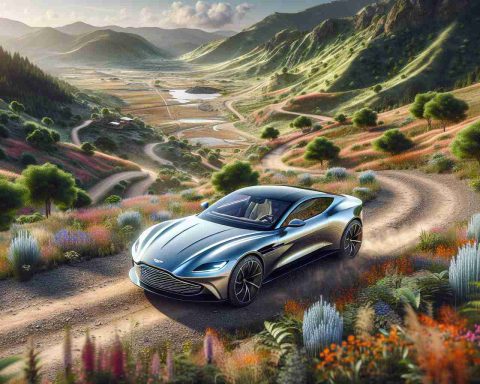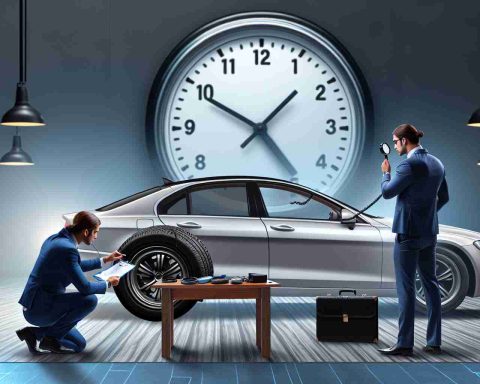- Aston Martin faces the challenge of balancing its traditional roaring engines with the shift towards electrification.
- CEO Adrian Hallmark is steering the brand through consumer sentiment and regulatory changes.
- The brand’s affluent clientele is resistant to transitioning from combustion engines to electric vehicles.
- An anticipated electric model may not be released until 2030, with debates on whether it will be a DBX SUV or an electric supercar.
- The situation reflects a broader industry struggle, as luxury brands adapt to a changing customer base.
- Aston Martin’s success depends on innovatively blending heritage with an electrified future that appeals emotionally to its audience.
Aston Martin stands at a crossroads, wrestling with the intricate dance between timeless tradition and rapid electric evolution. With the esteemed brand’s future humming on the wires of electrification, the landscape is anything but serene. As the distinct rumble of V-12 and V-8 engines stirs fervor among its affluent clientele, these legends of the road beckon a passionate loyalty that refuses to yield easily.
At the helm, CEO Adrian Hallmark finds himself navigating the churning seas of consumer sentiment and regulatory currents. The gauntlet is clear—how to harmonize the rich heritage of roaring engines with the forward march toward emissions-free propulsion. The brand’s strategy falters not at mere technological hurdles but in confronting a clientele resistant to change. These fervent buyers, whether billionaires or multi-millionaires, bristle at the idea of surrendering their roaring machines for a silent electric future.
Aston Martin’s journey to electrification has been a tapestry of delays and speculation. An electric model, once anticipated to dazzle roads this decade, may not see the light until 2030. The debate continues: Will the debut model emerge as an electrified DBX SUV or a pioneering all-electric supercar?
Beyond the allure of speed and luxury, Aston Martin’s saga encapsulates a broader industry struggle. The balance of power sways as brands like Bentley, Rolls-Royce, and Mercedes-Benz grapple with an evolving customer base—some avidly embracing tomorrow’s technology, others clinging to the cherished growl of combustion engines.
As the brand twines its storied past with an electric future, one anthem resounds: the evolving narrative of luxury demands not mere adaptation but innovation imbued with soul. Success hinges on weaving tradition with a vision that resonates, not just with industry insiders but with hearts yearning for the thrill of tomorrow.
The Electrifying Transformation of Aston Martin: What Lies Ahead?
How-To Steps & Life Hacks: Embracing Electric Vehicles
1. Understand Your Preferences: Identify what you love about your combustion engine vehicle and seek those characteristics—be it acceleration, handling, or luxury—in electric models.
2. Educate Yourself on Charging Infrastructure: Familiarize yourself with charging facilities, types of chargers, and the time required for charging.
3. Evaluate Ownership Costs: Compare the long-term maintenance costs of electric vehicles (EVs) versus internal combustion engine (ICE) vehicles. EVs often have lower maintenance costs due to fewer moving parts.
4. Transitioning Smoothly: Consider hybrids or plug-in hybrids as an intermediary step towards fully electric vehicles.
Real-World Use Cases: Where Electric Aston Martins Will Thrive
Electric Aston Martins could excel in urban environments where charging infrastructure is robust and range anxiety is minimal. Furthermore, zero-emission zones being implemented in cities worldwide create an advantageous setting for electric vehicle adoption.
Market Forecasts & Industry Trends
The luxury automotive segment is witnessing aggressive shifts towards electrification. According to a report by Allied Market Research, the global luxury car market is expected to hit $733 billion by 2026, with electrified luxury vehicles forming a substantial part of this growth. Industry leaders such as Bentley and Rolls-Royce have committed to going fully electric by the next decade.
Reviews & Comparisons: Aston Martin vs. Competitors
Aston Martin is juxtaposed against brands like Tesla, Porsche, and Mercedes-Benz that have established electric models. For instance, the Porsche Taycan offers exhilarating performance rivaling traditional sports cars. Aston Martin will need to match or surpass such expectations to captivate its loyal clientele.
Controversies & Limitations
Controversy: A significant challenge for Aston Martin is reconciling the heritage of its iconic sound and feel with the silent operation of EVs. The delayed rollouts and potential increased costs further complicate client perception.
Limitations: Aston Martin’s established clients may perceive ‘going electric’ as losing the tactile and auditory experience they cherish in a supercar.
Features, Specs & Pricing
While specific features of Aston Martin’s electric models are primarily speculative at this point, expectations include:
– Advanced battery technology for enhanced range
– High-performance electric motors for superior acceleration
– Premium luxury interiors
Pricing will likely compete with other high-end brands, potentially starting in the high six-figure range.
Security & Sustainability
Security: Electric vehicles often come with advanced software systems requiring regular updates to maintain cybersecurity.
Sustainability: EVs reduce tailpipe emissions significantly. However, Aston Martin could further bolster sustainability by leveraging recycled materials and implementing sustainable manufacturing processes.
Insights & Predictions
The integration of advanced AI and IoT (Internet of Things) within luxury EVs could transform user experiences, offering features such as autonomous driving capabilities and tailored in-car digital services.
Tutorials & Compatibility
Potential electric Aston Martin owners may benefit from resources on efficient charging practices and integrating smart home and car networks for seamless tech experiences.
Pros & Cons Overview
Pros:
– Lower environmental impact due to zero emissions
– Potentially lower maintenance costs
– Opportunities for innovation in design and technology
Cons:
– Potential loss of traditional sensory elements like engine sound
– High initial purchase costs
– Limited infrastructure and range in less urbanized regions
Actionable Recommendations
– For current Aston Martin enthusiasts, consider interim steps like leasing electric models to adjust over time.
– Stay informed about upcoming electric models and industry news.
– Participate in brand-hosted events or forums to share feedback that could shape future model developments.
Related Links
Visit the Aston Martin official site: Aston Martin
The key for Aston Martin lies not only in adapting to an electrified future but in crafting it with the same fervor and passion that has fueled its iconic history. The road ahead promises not just clean energy, but also a renaissance of luxury and performance that honors the past while embracing tomorrow.

















